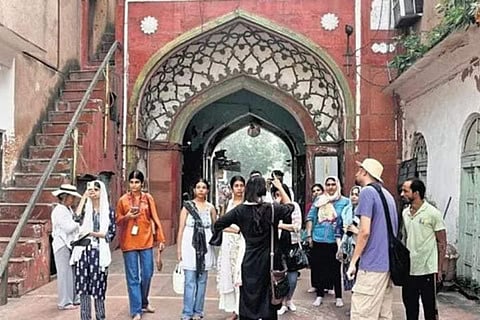
- LIFESTYLE
- FASHION
- FOOD
- ENTERTAINMENT
- EVENTS
- CULTURE
- VIDEOS
- WEB STORIES
- GALLERIES
- GADGETS
- CAR & BIKE
- SOCIETY
- TRAVEL
- NORTH EAST
- INDULGE CONNECT

Under the soft morning sun, a group of curious walkers huddle before the Town Hall in the bustling streets of Chandni Chowk. A question rings out: “Can anyone name a structure built by a woman in 2023?” No one seems to know. The group is thankful for the sounds of passing vehicles and rhythmic tinkling of rickshaw horns that engulf them.
In Old Delhi, every weather-beaten building has a story to tell - of women’s initiative and creative vision. From popular tourist spots in the Chowk to withering monuments nestled in the alleys, the structures stand as testaments to the architectural grandeur of the Mughal era, built not by its emperors but by the begums. Behind each curve of the bulbous domes and intricate designs on vaulted doors, was the vision of Mughal women; a historical fact that seems to have been forgotten over the years. Led by Anoushka Jain, the founder of the women-led organisation, Enroute Indian History, the heritage walk on ‘Badass Begums’, is an attempt to get in touch with this side of our past.
“Humayun’s tomb was designed by a woman, by his widow, Hajji Begum,” reveals Jain, addressing her own question. “Female architects were very popular at that time. How does one locate women in history when they are not named in official annals? They found a way around it through architecture, and this was a smart way to do it.”
Leaving a Stamp
Pointing at the Town Hall, a comparatively well-kept building painted in a shade of lime yellow, Jain reveals that before the building existed, there was a Sarai (motel) designed by Jahanara Begum, the oldest daughter of Emperor Shah Jahan. “In fact, she designed the entire Old Delhi area, including Chandni Chowk. She built an octagonal pool right across the sarai that reflected the moonlight. That’s where the name of the area came from,” adds Jain.
After the death of her mother Mumtaz Mahal, the 17-year-old princess was awarded the title of Padshah Begum. Jahanara managed the household, was entrusted with the royal seal, had a ship of her own and a cavalry of 50,000 and was her father’s advisor. The Sarai, also known as Begum ka Bagh, opened into a garden, which was a safe haven for women. While the garden remained, the sarai was razed by the British in 1850 to build a new structure now called Town Hall.
Jain also recalls a time when trams ran on the streets of Chandni Chowk in the early 20th century and the Clock Tower (Ghanta Ghar) became a spot for protests — Jain has come with black-and-white pictures of the tower and paintings of the sarai for the benefit of the walkers--against the British before Independence. Over the course of two hours, Jain walks the group through prominent monuments scattered across Chandni Chowk. On the way to Fatehpuri Masjid, Lala Chunnamal’s weather-worn haveli seems to beckon. As the group observes the rickety windows intact against the chipping walls, Jain sheds light on the infamous face-offs between trader Lala Chunnamal and poet Mirza Ghalib, who lived across the street.
Power Structures
In the sprawling area of Fathepuri Masjid, the intricate designs and arches catch the eye. One of Shah Jahan’s wives, Fatehpuri Begum, designed the masjid. “It was built in such a way that it was centrally aligned with the main throne of Hindustan at a good distance during the Mughal era, giving legitimacy to the throne,” Jain says.
The streets of Chandni Chowk soon become a sensory stimulus. Amidst the crowded market, one can hear the sizzling sound of oil as the smell of parathas wafts through the air. Muted voices of shopkeepers talking and bargaining become a distant hum as the group enters alleys connecting to the derelict sites of the Namak Haram and Khari Baoli.
Namak Haram, once a dream mansion of Bhawani Shankar Khatri, who was later named a traitor for siding with the British, is now slowly crumbling. The heritage walk ends at Zeenat Mahal which has two jharokas (balconies) overlooking the street. Zeenat, wife of Bahadur Shah Zafar, was the last Mughal empress. She was the power behind the throne; she held the purse strings and is believed to have even ordered a ‘hit’ on a British officer for meddling in Mughal affairs. “Women have always asserted their power in history and have been vilified for it. Yet they always found ways and channels to show who they were. This gives an idea of the badass begums, women who have been shattering the glass ceilings for centuries,” Jain says, visibly excited about the new project.
Jain has earlier organised ‘Tawaif Walks’. “There were many more monuments along the Civil Lines too, but I couldn’t cover them all at once. So, every weekend, I plan different themed heritage walks that explore the city,” she explains. One of her motivations behind the ‘Badass Begums Walk’, she says was to address the perceptions of people about the Mughal era. “A word like zenana is often sexualised when it was a room meant for women. Women have shown their prowess through the centuries, in this case, they were doing it through tangible architecture,” she says.